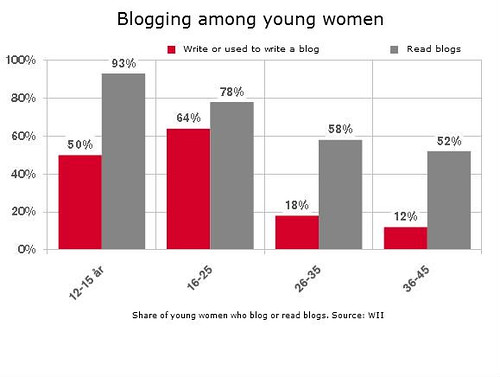To continue on the topic from the two previous posts, the blog is definitely not dead. It is changing and evolving, but I see few signs of its demise. Let me give you a short overview of the situation in Sweden. Back in early 2004, when I started blogging, the typical blogger was a man in his mid thirties who would blog about politics, media or tech stuff. Over the years the blogosphere grew rapidly and for the last few years it has grown into several different and somewhat overlapping sub-blogospheres with a complete dominance by young women.
Blogs written by teenage girls and women in their early twenties are attracting hundreds of thousands of visitors per week. In fact, the five most visited blogs in Sweden are all run by young women who blog about fashion and/or daily life experiences. Each one of them have more than a million visits per month and the largest has more than 4 million visits per month. Very few personal blogs in other larger European countries come even near that type of figures.
And the trend is clear, more people write and read blogs. According to the survey “Swedes and the internet” by IIS and WII, 6% of the population write a blog (or 8% of the online population over 12 years), which translates to 500,000 people.
Among young women, blogging has become an integral part of the web. As many as 93% of girls 12-15 years old read blogs.
With more options such as micro blogs and social networks, many of my blog readers have changed behaviour. When I previously could get several bloggers who commented on my content, today most of it is just shared via Facebook, retweeted on Twitter or collected in lists on blog tips on blogs. That’s not necessarily a bad thing since it generates a lot of visitors. So while many old-timers have decreased the frequency of blog posts (I have too), the ones that are able to continue to produce interesting content, will continue to attract an audience.
But as I mentioned, the blogosphere is not homogenous. There is a big difference between for example blogs about politics, media and fashion. When looking at different lists, you see a distinct pattern. The most visited blogs are about fashion and/or every day life experiences. The most linked to blogs are all about politics. To generalize and summarize I would say that the main differences in behaviour between these two sections of the blogosphere are:
- Fashion/lifestyle/diaries: Readers seldom use RSS, so visits to the actual blog are very high. Large traffic and high volume of comments spreads the traffic across a large number of similar blogs who all benefit from the traffic/commenting spiral.
- Politics: Readers more inclined to link to articles in media and to each others so blogs rank high on blog portals that track which articles are most debated and which blogs are most linked to.
Blogs make a difference
In the latest election in September, one single blog post generated more than 600 blog links and extensive media coverage just a few weeks before the election. And one of the top female bloggers recently revealed she invoiced 20,000 euro for a single month of blog ad revenue. As long as we can see these iconic examples of blogs making a difference, blogs won’t go away. They have become too powerful to just disappear.

